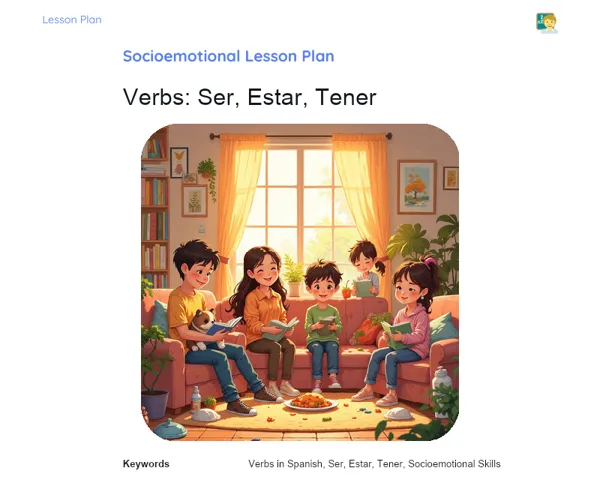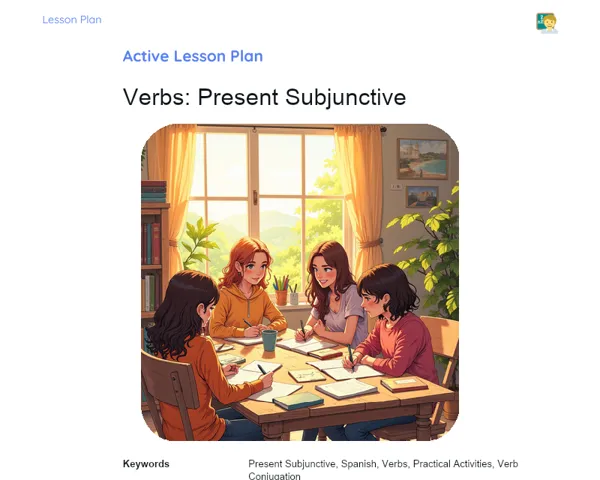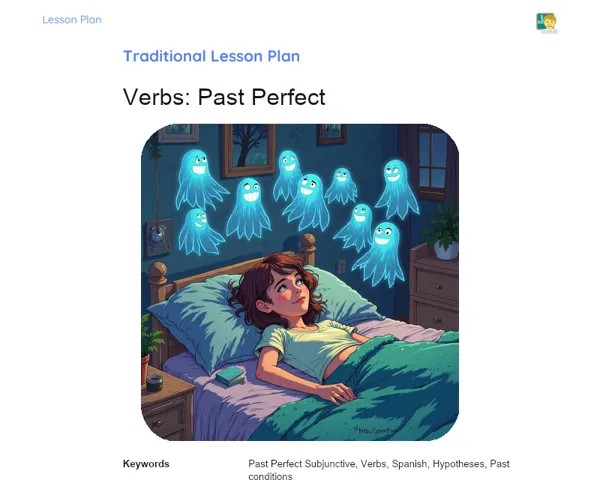Lesson Plan | Lesson Plan Tradisional | Verbs: Present Tense
| Keywords | Present Tense, Regular Verbs, Irregular Verbs, Conjugation, Practical Examples, Complete Sentences, Error Correction, Student Engagement, Daily Routine, Effective Communication |
| Resources | Whiteboard or chalkboard, Markers or chalk, Projector (optional), Slides or transparencies with conjugation examples, Conjugation exercise worksheets, Pens or pencils, Notebooks or paper for notes, Reference materials (books or Spanish grammar worksheets) |
Objectives
Duration: (10 - 15 minutes)
The aim of this lesson is to provide students with a straightforward and clear overview of the learning objectives. By establishing these goals, students will be able to focus on the most critical aspects of the material, helping them understand and internalize the rules for conjugating verbs in the present tense in Spanish.
Objectives Utama:
1. Understand how to conjugate regular verbs in the present tense.
2. Identify and conjugate irregular verbs in the present tense.
3. Use the correct verb forms in a variety of sentences and contexts.
Introduction
Duration: (10 - 15 minutes)
🎯 Purpose: This part of the lesson aims to put content into context and spark students' interest by highlighting the practical importance of learning verb conjugation in the present tense. By linking the lesson's theme to real-life situations and interesting facts, we're hoping to make learning more motivating and engaging for students.
Did you know?
🌍 Curiosity: Did you know that Spanish is the second most spoken language in the world among native speakers? Mastering verbs in the present tense will enable students to communicate effectively in a range of everyday situations, whether discussing their daily routines, expressing preferences, or describing what is happening right now.
Contextualization
📚 Context: Begin by explaining to students that verbs are a crucial part of communication in any language. They are essential for expressing actions, states, and events. In Spanish, just like in Portuguese, verbs are conjugated according to tense, mood, and person. Today, we'll focus on conjugating verbs in the present tense, which describes actions happening now or regularly. Understanding this conjugation is key to forming correct and effective sentences in Spanish.
Concepts
Duration: (55 - 60 minutes)
📝 Purpose: In this stage of the lesson, we aim to provide a comprehensive and practical understanding of verb conjugation in the present tense. By dealing with both regular and irregular verbs and offering clear examples and practical exercises, students will grasp the grammatical rules and be able to apply verb forms correctly in various sentences and contexts. This part also encourages active participation through guided exercises and problem-solving.
Relevant Topics
1. 📖 Topics:
2. Concept of Present Tense: Explain that the present tense describes actions occurring now or on a habitual basis. Provide examples in Spanish, such as 'Yo hablo', 'Tú comes', and 'Él vive'.
3. Regular Verbs: Discuss how to conjugate regular verbs in the three groups (-ar, -er, -ir). Show the specific endings for each personal pronoun (yo, tú, él/ella/usted, nosotros/nosotras, vosotros/vosotras, ellos/ellas/ustedes). Use clear examples like 'hablar' (yo hablo, tú hablas, él habla, etc.), 'comer' (yo como, tú comes, él come, etc.), and 'vivir' (yo vivo, tú vives, él vive, etc.).
4. Irregular Verbs: Explain that some verbs don't follow the regular conjugation rules and have changes in either the root or the endings. Provide common examples like 'tener' (yo tengo, tú tienes, él tiene), 'ir' (yo voy, tú vas, él va), and 'ser' (yo soy, tú eres, él es).
5. Using Present Tense in Sentences: Show how to use the conjugated verbs in complete sentences. Provide examples of positive, negative, and question forms. For instance, 'Yo estudio español todos los días', '¿Tú lees libros en español?' and 'Nosotros no comemos carne'.
6. Guided Practice: Conduct conjugation exercises with students, asking them to fill in the blanks or conjugate specific verbs. Review the exercises in class, discussing common errors and reinforcing grammatical rules.
To Reinforce Learning
1. Conjugate the verb 'hablar' in the present tense for all personal pronouns.
2. Write three sentences using the verbs 'comer', 'vivir', and 'tener' correctly conjugated in the present tense.
3. Identify and fix the errors in the following sentences: 'Yo hablas español', 'Nosotros vivimos en España', 'Ellos tienen una casa grande'.
Feedback
Duration: (15 - 20 minutes)
🔍 Purpose: This stage of the lesson is designed to provide an interactive review of the content covered, ensuring that students understand and internalize the rules of verb conjugation in the present tense. By discussing responses and engaging students in self-reflection and error correction, we promote a deeper, more meaningful learning experience.
Diskusi Concepts
1. 🗒️ Discussion: 2. Conjugation of the verb 'hablar': Highlight that 'hablar' is a regular verb from the first conjugation (-ar) and its present tense conjugation is: yo hablo, tú hablas, él/ella/usted habla, nosotros/nosotras hablamos, vosotros/vosotras habláis, ellos/ellas/ustedes hablan. 3. Sentences with 'comer', 'vivir' and 'tener': For 'comer', one might write 'Yo como una manzana todos los días'. For 'vivir', a suitable sentence could be 'Nosotros vivimos en una casa grande'. And for 'tener', an example could be 'Ella tiene un perro'. These sentences reinforce the correct conjugation of verbs in the present tense. 4. Correction of errors: The statement 'Yo hablas español' is incorrect as 'hablas' is for 'tú'. The correct form is 'Yo hablo español'. The sentence 'Nosotros vivimos en España' is fine. The sentence 'Ellos tene una casa grande' is wrong because 'tene' is not a correct form. The right form is 'Ellos tienen una casa grande.'
Engaging Students
1. 🗨️ Student Engagement: 2. Reflective Question: Why is it important to get the conjugation of verbs in the present tense right? How does this impact communication in Spanish? 3. Group Discussion: Have students share sentences they might use in their daily lives that include verbs in the present tense, discussing the different forms and necessary corrections. 4. Personal Example: Ask students to write a short description of their daily routine using verbs in the present tense. Discuss the various shared routines and correct any conjugation mistakes in their descriptions.
Conclusion
Duration: (10 - 15 minutes)
The aim of this lesson stage is to review and reinforce the knowledge gained during the lesson, ensuring students have a clear and applicable understanding of the rules of verb conjugation in the present tense. By summarising the key points and connecting theory to practice, we ensure that students are equipped to use their newly acquired knowledge in their daily Spanish interactions.
Summary
['Conjugating verbs in the present tense in Spanish is vital for expressing actions that occur now or regularly.', 'Verbs can be classified as regular or irregular, each with its unique conjugation rules.', 'Regular verbs follow specific patterns for the endings -ar, -er, and -ir.', 'Irregular verbs have variations in the root or endings and must be memorized individually.', 'Practicing writing and correcting sentences aids in understanding the rules of conjugation and enhances oral and written communication in Spanish.']
Connection
The lesson successfully connected theory with practice by giving detailed explanations about verb conjugation rules in the present tense and then applying these concepts through practical exercises. Clear examples and guided activities helped students to see how the rules function in real-life circumstances and everyday sentences, enhancing comprehension and practical use of the material.
Theme Relevance
Understanding the conjugation of verbs in the present tense is essential for effective communication in Spanish. This knowledge allows students to discuss their daily routines, describe current actions, and express preferences and opinions. Additionally, as Spanish is spoken widely across the globe, mastering verb usage enriches their ability to communicate socially and professionally.



